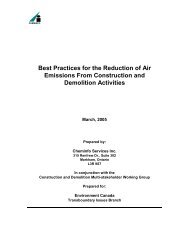Burrard Inlet Environmental Indicators Report - the BIEAP and ...
Burrard Inlet Environmental Indicators Report - the BIEAP and ...
Burrard Inlet Environmental Indicators Report - the BIEAP and ...
Create successful ePaper yourself
Turn your PDF publications into a flip-book with our unique Google optimized e-Paper software.
<strong>Burrard</strong> <strong>Inlet</strong> <strong>Environmental</strong> <strong>Indicators</strong> <strong>Report</strong> February 2008<br />
Considering only <strong>the</strong> developable areas, 51% of <strong>the</strong> l<strong>and</strong> has park or protected status. The amount<br />
varies among <strong>the</strong> catchment areas, as shown in Table 2-3. The total for Classes 1 through 3 is<br />
27% for Port Moody Arm, 32% for English Bay, 36% for Inner Harbour catchment <strong>and</strong> 78% for<br />
Indian Arm.<br />
Table 2-3: Proportion of L<strong>and</strong> in Management Classes for Each <strong>Burrard</strong> <strong>Inlet</strong> Catchment<br />
Management Class English Inner Indian Arm Port Moody<br />
Bay Harbour<br />
Arm<br />
Class 1 23% 18% 42% 2%<br />
Class 2 9% 18% 15% 25%<br />
Class 3 0% 0% 21% 0%<br />
Unclassified (outside Metro Vancouver) 0% 0% 1% 0%<br />
No class (residential <strong>and</strong> urban areas) 68% 65% 22% 73%<br />
In <strong>the</strong> undeveloped areas, 76% of <strong>the</strong> l<strong>and</strong> is in Classes 1 through 3 <strong>and</strong> 21% is in remote areas<br />
beyond <strong>the</strong> Metro Vancouver boundary. With a high proportion of protected l<strong>and</strong> <strong>and</strong> mountain terrain<br />
that restricts extensive development, <strong>the</strong> undeveloped area is likely to remain in its current state.<br />
These data provide a baseline for monitoring changes in amounts of parks <strong>and</strong> protected areas as<br />
development pressures increase. It does not assess <strong>the</strong> quality of habitat preserved, or <strong>the</strong> amount<br />
of wildlife inhabiting <strong>the</strong> protected area. Although <strong>the</strong>re is no dedicated habitat quality monitoring<br />
program for <strong>the</strong> watershed, it can be assumed that l<strong>and</strong> in Class 1 provides <strong>the</strong> most benefits for<br />
wildlife because <strong>the</strong>se forests are largely intact, with restrictions to human use <strong>and</strong> development,<br />
<strong>and</strong> topographic limitations to human access. These limitations protect natural ecosystems, <strong>and</strong><br />
<strong>the</strong> benefits of Class 1 protected areas can be seen in <strong>the</strong> outcomes of o<strong>the</strong>r indicators, such as<br />
tree canopy, air quality <strong>and</strong> water quality.<br />
What more can we do to maintain protected areas?<br />
Government policy, public awareness <strong>and</strong> certification programs for park management all play a<br />
role in enhancing <strong>the</strong> natural environment <strong>and</strong> preserving parks <strong>and</strong> protected areas.<br />
• Governments can designate l<strong>and</strong> use within <strong>the</strong> management classes, ensuring that highly<br />
valued recreational opportunities do not have a detrimental impact on <strong>the</strong> surrounding<br />
sensitive ecosystems<br />
• Limiting intensive recreational activities such as mountain biking <strong>and</strong> ATVs to designated<br />
areas will help ensure <strong>the</strong> quality of protected l<strong>and</strong> is maintained<br />
• Pesticide use in parks, golf courses <strong>and</strong> residential areas can be limited or eliminated to<br />
protect <strong>the</strong> natural environment <strong>and</strong> human health. This can be encouraged through by-laws,<br />
parks management plans, demonstration gardens, or <strong>the</strong> Audubon Sanctuary Protection<br />
Program (an international education <strong>and</strong> certification initiative that helps golf courses<br />
preserve <strong>the</strong> environment)<br />
• Park users are encouraged to explore protected areas respectfully <strong>and</strong> enjoy <strong>the</strong> recreational<br />
opportunities. This means treading lightly with activities that do not damage <strong>the</strong> forest, being<br />
mindful of wildlife <strong>and</strong> leaving no waste.<br />
For more information…<br />
• http://www.audubonintl.org/programs/acss/golf.htm<br />
• http://www.env.gov.bc.ca/bcparks/legacy.html<br />
• http://www.pac.dfompo.gc.ca/recfish/Restricted_Areas/RCAs/booklet/RCA_booklet_2007.pdf<br />
Page | 19
















